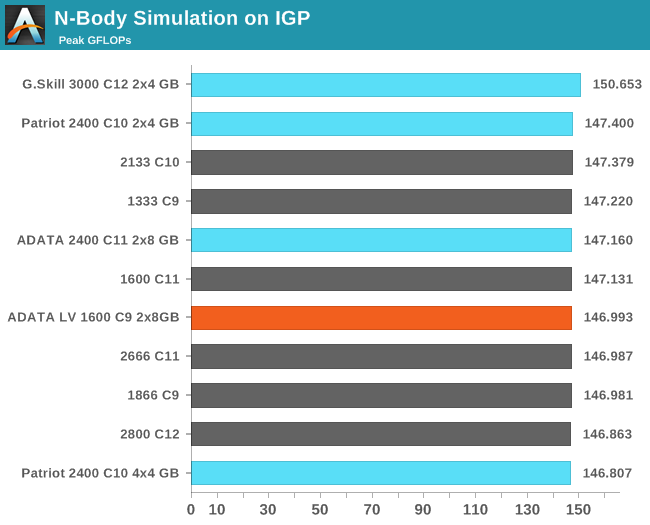ADATA XPG V1.0 Low Voltage Review: 2x8 GB at DDR3L-1600 9-11-9 1.35 V
by Ian Cutress on December 6, 2013 2:00 PM ESTIGP Compute
One of the touted benefits of Haswell is the compute capability afforded by the IGP. For anyone using DirectCompute or C++ AMP, the compute units of the HD 4600 can be exploited as easily as any discrete GPU, although efficiency might come into question. Shown in some of the benchmarks below, it is faster for some of our computational software to run on the IGP than the CPU (particularly the highly multithreaded scenarios).
Grid Solvers - Explicit Finite Difference on IGP
As before, we test both 2D and 3D explicit finite difference simulations with 2n nodes in each dimension, using OpenMP as the threading operator in single precision. The grid is isotropic and the boundary conditions are sinks. We iterate through a series of grid sizes, and results are shown in terms of ‘million nodes per second’ where the peak value is given in the results – higher is better.


On our IGP compute the 1600 C9 LV takes a bit of a knock in both 2D and 3D simulations when compared to the more powerful kits available - by as much as 10% in 3D.
N-Body Simulation on IGP
As with the CPU compute, we run a simulation of 10240 particles of equal mass - the output for this code is in terms of GFLOPs, and the result recorded was the peak GFLOPs value.

3D Particle Movement on IGP
Similar to our CPU Compute algorithm, we calculate the random motion in 3D of free particles involving random number generation and trigonometric functions. For this application we take the fastest true-3D motion algorithm and test a variety of particle densities to find the peak movement speed. Results are given in ‘million particle movements calculated per second’, and a higher number is better.

Matrix Multiplication on IGP
Matrix Multiplication occurs in a number of mathematical models, and is typically designed to avoid memory accesses where possible and optimize for a number of reads and writes depending on the registers available to each thread or batch of dispatched threads. He we have a crude MatMul implementation, and iterate through a variety of matrix sizes to find the peak speed. Results are given in terms of ‘million nodes per second’ and a higher number is better.











35 Comments
View All Comments
MrSpadge - Sunday, December 8, 2013 - link
> Does low voltage ram avoid this?Nope. It's actually the signal quality and not the power draw which causes them to downclock. I've got a X79 build with 8x8 GB where I simply set XMP at stock frequency (1600 or 1866) and it works without problems. I think it's the same as overclocking memory and controller: Intel doesn't want to validate this, but this doesn't mean it would not work.
BlueReason - Saturday, December 7, 2013 - link
Do you ever look at all the charts full of near-identical sized bars and ask yourself just how worthwhile these RAM reviews are?ShieTar - Tuesday, December 10, 2013 - link
Well, some RAM testing is fundamentally important, in order to understand how much impact there is with current CPUs, RAM, Software, etc.What may be less useful is posting a full article that shows just how little impact there is right now, and then following it up with a steady stream of single RAM tests that only keep on reporting the same conclusion over and over.
cjs150 - Monday, December 9, 2013 - link
I use low profile/low voltage samsung green for my HTPC (which is fanless). Lower voltage = less heat which is obviously beneficial in a fanless computer. The fact that the samsungs were the same price as a good name standard ram meant the decision was very simple.If not going fanless then I would still go for the samsungs where memory height was an issue for a big CPU cooler.
Low voltage is a niche
blackie333 - Tuesday, December 10, 2013 - link
A have a brand new Haswell build with 4670K, Asus Z87-Pro and G.Skill 2400C10 memory. I was quite surprised that in idle mode G.Skill@2400Mhz is consuming much more energy(10Watts) than CPU cores (1-5 watts).Is there any bios setting (except setting DRAM frequency manually too low) to make memory be more effective in idle state(s)? Thank you in advance for advice